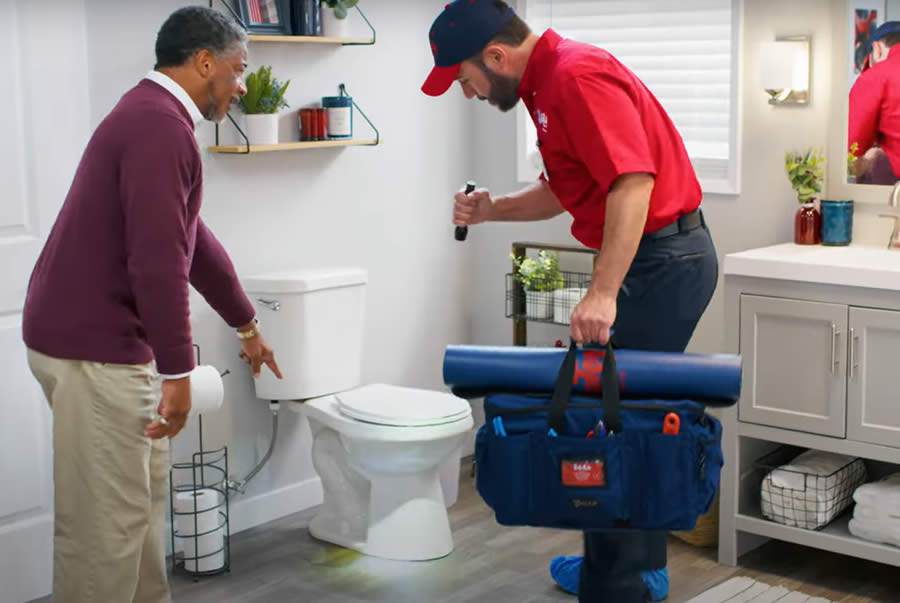Schedule a Plumber This Sunday to Get 50$ OFF
Schedule a Plumber This Sunday to Get 50$ OFF

If you don’t know what to do, stopping an overflowing toilet may feel like an endless race against time combined with panic. Luckily, though, the steps to manage this common household disaster are straightforward, helping prevent potential water damage, toilet repair, and stress levels from mounting. This guide by Mr. Rooter Plumbing will walk through how to stop an overflowing toilet step by step.
Quickly stopping an overflow is critical once your toilet bowl fills with alarming water. Your initial action should involve stopping more from entering by reaching into your tank and pressing down on its flapper valve (the rubber stopper at the bottom). This prevents further flow towards your bowl—often enough, this immediate stoppage of flow alone is enough to halt an imminent overflow.
If your first steps don't work or you just want to ensure no more water enters, locate and turn the shut-off valve behind your toilet near its floor clockwise. This action cuts off its supply, giving you time and breathing room when planning what steps will come next.
As most toilet overflows are caused by clogs in the drain, you should arm yourself with a plunger designed for toilet use; one with an extended rubber piece known as a "flange" would work better for this task. Hold your breath once in position over the toilet bowl drain hole and give several firm, steady plunges! Ultimately, you want enough pressure applied that the clog will dislodge itself. Once the water starts draining back down, flush your bowl when all seems normal, but be ready to stop it again should anything go amiss!
Sometimes, a plunger simply won't cut it; if, after exerting effort, the toilet still won't drain after using all possible attempts at unplugging it yourself, professional plumbing services offer more advanced solutions such as hydro jet or a plumbing snake to unclog stubborn clogs. They have all the tools and expertise required to diagnose and solve your plumbing problem immediately - often finding issues not immediately apparent by untrained eyes.
Preventing future toilet overflows is equally crucial to understanding how to stop them. Regular maintenance and taking proper precautions will go far toward keeping overflows from happening again - for instance, avoiding flushing items other than human waste (toilet paper and human feces only!) into your sewer line, such as sanitary products, wipes (even those labeled flushable), cotton balls, etc. Also, consider hiring professional plumbing repair service inspectors regularly to identify issues before they lead to another overflow; for instance, they could locate issues like toilet repair/replacement before leading them down an overflow cycle again!
Are clogs and overflows becoming an ongoing problem in your household? A toilet replacement could be just what's necessary; modern models use less water while providing increased flushing power, thus decreasing the chances of clogging. Consulting with a plumber to select and ensure the correct installation will simplify this task.
Informing everyone in your household about what belongs in and should not belong in the toilet is crucial to avoiding potential clogs and preventing overflow damage if an overflow does happen. A simple rule such as only using toilet paper and natural products in the bowl will protect against future blockages. Furthermore, showing them how to turn off their water source when an emergency arises could prove invaluable in minimizing damage.
Preventing your toilet from overflowing involves swift actions, using appropriate tools, and knowing when to contact a plumber from Mr. Rooter Plumbing. By taking these steps, you can avoid the panic and chaos caused by an overflowing toilet. Regular maintenance with foresight may prevent most issues. When in doubt, call the professionals. They provide toilet repair or replacement services that ensure proper functioning while safeguarding against potential water damage in your home.
A garbage disposal is one of the most convenient tools in the entire modern home. Unfortunately, most homeowners misuse the disposal as a way to get rid of organic waste.…
If you’ve been dealing with faucet leaks for some time and plumbers in Killeen, TX mentioned that faucet repair was not possible, you might find yourself standing in…
Most homeowners don’t think about the importance of a shower until they face a problem with it. A minor problem in the shower can quickly escalate into a major headache.…